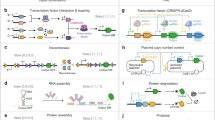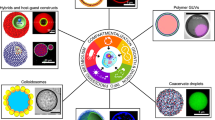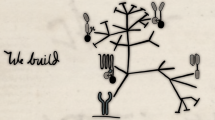Key Points
-
Efforts to engineer cells with customized signalling circuits will teach us about the design principles underlying natural signalling networks and could lead to important applications in medicine and biotechnology, such as specialized anti-cancer cells.
-
There have been exciting recent developments in engineering synthetic or modified sensors and receptors that allow novel inputs to control complex natural responses or allow natural inputs to control novel responses. Engineered sensors have also been developed that allow small molecules or light to precisely control biological responses.
-
Engineering highly diverse sensors remains a big challenge in synthetic biology. However, some examples, such as chimeric T cell receptors that incorporate a single-chain antibody as the extracellular domain, offer a strategy for custom receptor design.
-
The modularity of intracellular signalling proteins can be exploited to generate diverse signal processing circuits. Many protein circuits are dependent on the organization of key proteins into specific complexes and assemblies. Thus, recombination and reorganization of specific catalytic domains with different interaction domains provides a way for both evolution and engineering to generate novel circuit wiring.
-
The modification of spatially controlled signalling circuits can lead to cells with new morphological behaviours.
-
Advances that may facilitate the engineering of customized signalling include improved molecular tool kits that are optimized for predictability, and incorporation of combinatorial library design into the engineering process.
Abstract
Living cells have evolved a broad array of complex signalling responses, which enables them to survive diverse environmental challenges and execute specific physiological functions. Our increasingly sophisticated understanding of the molecular mechanisms of cell signalling networks in eukaryotes has revealed a remarkably modular organization and synthetic biologists are exploring how this can be exploited to engineer cells with novel signalling behaviours. This approach is beginning to reveal the logic of how cells might evolve innovative new functions and moves us towards the exciting possibility of engineering custom cells with precise sensing–response functions that could be useful in medicine and biotechnology.
This is a preview of subscription content, access via your institution
Access options
Subscribe to this journal
Receive 12 print issues and online access
$189.00 per year
only $15.75 per issue
Buy this article
- Purchase on Springer Link
- Instant access to full article PDF
Prices may be subject to local taxes which are calculated during checkout







Similar content being viewed by others
References
Pryciak, P. M. Designing new cellular signaling pathways. Chem. Biol. 16, 249–254 (2009).
Kiel, C., Yus, E. & Serrano, L. Engineering signal transduction pathways. Cell 140, 33–47 (2010).
Elowitz, M. B. & Leibler, S. A synthetic oscillatory network of transcriptional regulators. Nature 403, 335–338 (2000).
Gardner, T. S., Cantor, C. R. & Collins, J. J. Construction of a genetic toggle switch in Escherichia coli. Nature 403, 339–334 (2000).
Sprinzak, D. & Elowitz, M. B. Reconstruction of genetic circuits. Nature 438, 443–448 (2005).
Mukherji S. & van Oudenaarden, A. Synthetic biology: understanding biological design from synthetic circuits. Nature Rev. Genet. 10, 859–871 (2009).
Bashor, C. J., Horwitz, A. A., Peisajovich, S. G. & Lim W. A. Rewiring cells: synthetic biology as a tool to interrogate the organizational principles of living systems. Annu. Rev. Biophys. 16 Feb 2010 (doi: 10.1146/annurev.biophys.050708.133652).
Yeh, B. J. & Lim W. A. Synthetic biology: lessons from the history of synthetic organic chemistry. Nature Chem. Biol. 3, 521–525 (2007).
Weinberg, R. The Biology of Cancer (Garland Science 2006).
Galán, J. E. Common themes in the design and function of bacterial effectors. Cell Host Microbe. 5, 571–579 (2009).
Münter, S., Way, M. & Frischknecht, F. Signaling during pathogen infection. Sci. STKE. re5 (2006).
Shan, L., He, P. & Sheen, J. Intercepting host MAPK signaling cascades by bacterial type III effectors. Cell Host Microbe. 1, 167–174 (2007).
Kiskinis, E. & Eggan, K. Progress toward the clinical application of patient-specific pluripotent stem cells. J. Clin. Invest. 120, 51–59 (2010).
Lindvall, O. & Kokaia, Z. Stem cells in human neurodegenerative disorders — time for clinical translation? J. Clin. Invest. 120, 29–40 (2010).
June, C. H. Adoptive T cell therapy for cancer in the clinic. J. Clin. Invest. 117, 1466–1476 (2007).
Varela-Rohena, A. et al. Genetic engineering of T cells for adoptive immunotherapy. Immunol. Res. 42, 166–181 (2008).
Lee, S. K., Chou, H., Ham, T. S., Lee, T. S. & Keasling, J. D. Metabolic engineering of microorganisms for biofuels production: from bugs to synthetic biology to fuels. Curr. Opin. Biotechnol. 19, 556–563 (2008).
Sadelain, M., Brentjens, R. & Rivière, I. The promise and potential pitfalls of chimeric antigen receptors. Curr. Opin. Immunol. 21, 215–223 (2009).
June, C. H., Blazar, B. R. & Riley, J. L. Engineering lymphocyte subsets: tools, trials and tribulations. Nature Rev. Immunol. 9, 704–716 (2009).
Tlsty, T. D. & Coussens, L. M. Tumor stroma and regulation of cancer development. Annu. Rev. Pathol. 1, 119–150 (2006).
Pawson, T. & Nash, P. Assembly of cell regulatory systems through protein interaction domains. Science 300, 445–452 (2003).
Bhattacharyya, R. P., Reményi, A., Yeh, B. J. & Lim, W. A. Domains, motifs, and scaffolds: the role of modular interactions in the evolution and wiring of cell signaling circuits. Annu. Rev. Biochem. 75, 655–680 (2006).
Gerhart, J. & Kirschner, M., The theory of facilitated variation, Proc. Natl Acad. Sci. USA 104 (Suppl 1), 8582–8589 (2007).
Kashtan, N., Alon, U., Spontaneous evolution of modularity and network motifs. Proc. Natl Acad. Sci. USA 102, 13773–13778 (2005). A theoretical study showing how functional modules can spontaneously emerge from networks that are placed under variable functional selections.
Carroll S. B. Evo-devo and an expanding evolutionary synthesis: a genetic theory of morphological evolution. Cell 134, 25–36 (2008).
Scott, J. D. & Pawson, T. Cell signaling in space and time: where proteins come together and when they're apart. Science 326, 1220–1224 (2009).
Peisajovich, S., Garbarino, J. Wei, P. & Lim, W. A. Rapid diversification of cell signaling phenotypes by modular domain recombination. Science 328, 368–372 (2010).
Struhl, G. & Adachi, A. Nuclear access and action of notch in vivo. Cell 93, 649–660 (1998).
Sprinzak, D. et al. Cis interactions between Notch and Delta generate mutually exclusive signaling states. Nature 25 April 2010 (doi:10.1038/nature08959).
Barnea, G. et al. The genetic design of signaling cascades to record receptor activation. Proc. Natl Acad. Sci. USA 105, 64–69 (2008). Engineering of synthetic receptor systems inspired by the mechanisms of Notch signalling.
Howard, P. L., Chia, M. C., Del Rizzo, S., Liu, F. F. & Pawson, T. Redirecting tyrosine kinase signaling to an apoptotic caspase pathway through chimeric adaptor proteins. Proc. Natl Acad. Sci. USA 100, 11267–11272 (2003).
Conklin, B. R. et al. Engineering GPCR signaling pathways with RASSLs. Nature Methods 5, 673–678 (2008).
Armbruster, B. N., Li, X., Pausch, M. H., Herlitze, S. & Roth, B. L. Evolving the lock to fit the key to create a family of G protein-coupled receptors potently activated by an inert ligand. Proc. Natl Acad. Sci. USA 104, 5163–5168 (2007).
Coward, P. et al. Controlling signaling with a specifically designed Gi-coupled receptor. Proc. Natl Acad. Sci. USA 95, 352–357 (1998).
Zhao, G. Q. et al. The receptors for mammalian sweet and umami taste. Cell 115, 255–266 (2003).
Redfern, C. H. et al. Conditional expression and signaling of a specifically designed Gi-coupled receptor in transgenic mice. Nature Biotech. 17, 165–169 (1999).
Corson, T. W., Aberle, N. & Crews, C. M. Design and applications of bifunctional small molecules: why two heads are better than one. ACS Chem. Biol. 3, 677–692 (2008).
Pollock, R. & Clackson, T. Dimerizer-regulated gene expression. Curr. Opin. Biotechnol. 13, 459–467 (2002).
Irving, B. A. & Weiss, A. The cytoplasmic domain of the T cell receptor ζ chain is sufficient to couple to receptor-associated signal transduction pathways. Cell 64, 891–901 (1991).
Gross, G., Waks, T. & Eshhar, Z. Expression of immunoglobulin-T-cell receptor chimeric molecules as functional receptors with antibody-type specificity. Proc. Natl Acad. Sci. USA. 86, 10024–10028 (1993). Shows that antibodies and T cell receptor components can be combined to create functional chimeric antigen receptors that can activate and target T cells towards specific antigens.
Eshhar, Z., Waks, T., Bendavid, A. & Schindler, D. G. Functional expression of chimeric receptor genes in human T cells. J. Immunol. Methods 248, 67–76 (2001).
Maher, J., Brentjens, R. J., Gunset, G., Rivière, I. & Sadelain, M. Human T-lymphocyte cytotoxicity and proliferation directed by a single chimeric TCRζ /CD28 receptor. Nature Biotech. 20, 70–75 (2002).
Carpenito, C. et al. Control of large, established tumor xenografts with genetically retargeted human T cells containing CD28 and CD137 domains. Proc. Natl Acad. Sci. USA 106, 3360–3365 (2009).
Zhang, F., Aravanis, A. M., Adamantidis A, de Lecea, L. & Deisseroth, K. Circuit-breakers: optical technologies for probing neural signals and systems. Nature Rev. Neurosci. 8, 577–581 (2007).
Airan, R. D. Thompson, K. R., Fenno, L. E., Bernstein, H. & Deisseroth, K. Temporally precise in vivo control of intracellular signalling. Nature 458, 1025–1029 (2009).
Levskaya, A., Weiner, O. D., Lim, W. A. & Voigt C. A. Spatiotemporal control of cell signalling using a light-switchable protein interaction. Nature 461, 997–1001 (2009).
Wu, Y. I. et al. A genetically encoded photoactivatable Rac controls the motility of living cells. Nature 461, 104–108 (2009). References 46 and 47 describe genetically encoded light-gated protein interaction modules that can be linked to specific cell signalling proteins to control their activity.
Lim, W. A. The modular logic of signaling proteins: building allosteric switches from simple binding domains. Curr. Opin. Struct. Biol. 12, 61–68 (2002).
Prehoda, K. E., Scott, J. A., Mullins, R. D. & Lim, W. A. Integration of multiple signals through cooperative regulation of the N-WASP-Arp2/3 complex. Science 290, 801–806 (2000).
Yu, B. et al. Structural and energetic mechanisms of cooperative autoinhibition and activation of Vav1. Cell 140, 246–256 (2010).
Dueber, J. E., Yeh, B. J., Chak, K. & Lim, W. A. Reprogramming control of an allosteric signaling switch through modular recombination. Science 301, 1904–1908 (2003).
Yeh, B. J., Rutigliano, R. J., Deb, A., Bar-Sagi, D. & Lim W. A. Rewiring cellular morphology pathways with synthetic guanine nucleotide exchange factors. Nature 447, 596–600 (2007).
Dueber, J. E., Mirsky, E. A. & Lim, W. A. Engineering synthetic signaling proteins with ultrasensitive input/output control. Nature Biotech. 25, 660–662 (2007). References 51–53 show how new signalling switches can be constructed by combining catalytic domains with novel sets of autoinhibitory regulatory domains.
Yadav, S. S., Yeh, B. J., Craddock, B. P., Lim, W. A. & Miller, W. T. Reengineering the signaling properties of a Src family kinase. Biochemistry 48, 10956–10962 (2009).
Garrington, T. P. & Johnson, G. L. Organization and regulation of mitogen-activated protein kinase signaling pathways. Curr. Opin. Cell Biol. 11, 211–218 (1999).
Schwartz, M. A. & Madhani, H. D. Principles of MAP kinase signaling specificity in Saccharomyces cerevisiae. Annu. Rev. Genet. 38, 725–748 (2004).
Choi, K. Y., Satterberg, B., Lyons, D. M. & Elion, E. A. Ste5 tethers multiple protein kinases in the MAP kinase cascade required for mating in S. cerevisiae. Cell 78, 499–512 (1994).
Printen, J. A. & Sprague G. F. Jr. Protein-protein interactions in the yeast pheromone response pathway: Ste5p interacts with all members of the MAP kinase cascade. Genetics 138, 609–619 (1994).
Posas, F. & Saito, H. Osmotic activation of the HOG MAPK pathway via Ste11p MAPKKK: scaffold role of Pbs2p MAPKK. Science 276, 1702–1705 (1997).
Park, S. H., Zarrinpar, A. & Lim, W. A. Rewiring MAP kinase pathways using alternative scaffold assembly mechanisms. Science 299, 1061–1064 (2003).
Harris, K. et al. Role of scaffolds in MAP kinase pathway specificity revealed by custom design of pathway-dedicated signaling proteins. Curr. Biol. 11, 1815–1824 (2001). References 60 and 61 show how linking yeast kinases in new ways through synthetic scaffold proteins or covalent fusion can lead to novel pathway wiring.
Dodge-Kafka, K. L. et al. The protein kinase A anchoring protein mAKAP coordinates two integrated cAMP effector pathways. Nature 437, 574–578 (2005).
Mishra, P. et al. Dynamic scaffolding in a G protein-coupled signaling system. Cell 131, 80–92 (2007).
Bashor, C. J., Helman, N. C., Yan, S. & Lim W. A. Using engineered scaffold interactions to reshape MAP kinase pathway signaling dynamics. Science 319, 1539–1543 (2008). Shows that scaffold proteins can serve as a highly flexible platform to engineer new pathway feedback loops and shape pathway dynamics.
Chant, J. Cell polarity in yeast. Annu. Rev. Cell Dev. Biol. 15, 365–391 (1999).
Kozubowski, L. et al. Symmetry-breaking polarization driven by a Cdc42p GEF-PAK complex. Curr. Biol. 18, 1719–1726 (2008).
Howell, A. S. et al. Singularity in polarization: rewiring yeast cells to make two buds. Cell 139, 731–743 (2009). An analysis of alternative signalling circuits that control yeast polarity, revealing that the kinetics of localization determine the degree of singularity (a single dominant pole).
Zarrinpar, A., Park, S. H. & Lim, W. A. Optimization of specificity in a cellular protein interaction network by negative selection. Nature 426, 676–680 (2003).
Stiffler, M. A. et al. PDZ domain binding selectivity is optimized across the mouse proteome. Science 317, 364–369 (2007).
Ernst, A. et al. Rapid evolution of functional complexity in a domain family. Sci. Signal 2, ra50 (2009).
Grigoryan, G., Reinke, A. W. & Keating, A. E. Design of protein-interaction specificity gives selective bZIP-binding peptides. Nature 458, 859–864 (2009).
Huang, J., Koide, A., Makabe, K. & Koide, S. Design of protein function leaps by directed domain interface evolution. Proc. Natl Acad. Sci. USA 105, 6578–6583 (2008).
Sauer, B. Inducible gene targeting in mice using the Cre/lox system. Methods 14, 381–392 (1998). References 70, 71 and 73 show how protein interaction domains can be engineered to achieve improved specificity.
Yokobayashi, Y., Weiss, R. & Arnold F. H. Directed evolution of a genetic circuit. Proc. Natl Acad. Sci. USA 99, 16587–16591 (2002).
Acknowledgements
I thank the following colleagues for many insightful discussions: C. Bashor, B. Conklin, J. Dueber, M. Dustin, D. Fletcher, C. June, A. Levskaya, M. Milone, R.D. Mullins, J. Onuffer, J. Park, B. Rhau, C. Voigt, O. Weiner, W. Wong and B. Yeh. This work was supported by grants from the National Institutes of Health (the Institute of General Medicine and the Nanomedicine Development Centers), the National Science Foundation Engineering Research Centers, the Packard Foundation and the Howard Hughes Medical Institute.
Author information
Authors and Affiliations
Ethics declarations
Competing interests
Bart Vanhaesebroeck is an advisor to Intellikine (San Diego, uSA) and Karus Therapeutics (Southampton, uK).
Supplementary information
Related links
Related links
FURTHER INFORMATION
Glossary
- Adoptive immunotherapy
-
A therapeutic strategy in which a patient's lymphocytes are removed, modified or manipulated ex vivo and retransfused to the patient. This is often used in the treatment of cancer.
- T lymphocyte
-
A lymphocyte that expresses heterodimeric receptors associated with the CD3 complex. Effector T lymphocytes (or T cells) carry out a variety of functions, acting through interactions with other cells (for example, activating macrophages or helping B cells produce antibodies). Cytotoxic T cells kill cells infected with intracellular pathogens.
- Natural killer cell
-
A class of lymphocytes that is crucial in the innate immune response. Natural killer cells exert a cytotoxic activity on target cells (such as virus-infected cells) that is enhanced by cytokines such as interferons.
- SH2 domain
-
(SRC homology 2 domain). A protein motif that recognizes and binds Tyr-phosphorylated sequences and thereby has a key role in relaying cascades of signal transduction.
- Orthogonal signal
-
A signal that only reacts with its cognate ligand and does not cross react with the host proteome.
- Heterotrimeric G protein
-
A protein complex of three proteins (Gα, Gβ and Gγ). Gβ and Gγ form a tight complex, which Gα is a part of when the complex is in its inactive GDP-bound form, but dissociates from when the complex is in its active GTP-bound form. Both Gα and Gβγ can transmit downstream signals after activation.
- PIF domain
-
(Phytochrome-interacting bHLH factor domain). A plant protein interaction domain that selectively binds to the light-activated state of the phytochrome domain. The phytochrome–PIF interaction is normally involved in transcriptional regulation of plants, but can be introduced into diverse organisms and cell types to control the recruitment and activity of fused protein activities.
- Guanine nucleotide exchange factor
-
(GEF). A protein that activates a specific small GTPase by catalysing the exchange of bound GDP for GTP.
- Michaelis constant (Km)
-
A kinetic parameter for a specific substrate in an enzyme-catalysed reaction. Km equals the concentration of substrate that yields half-maximal velocity of the reaction. Providing certain conditions are met, the Km for a substrate can equate to its binding constant, and the lower the value of Km, the tighter the substrate binds.
- PDZ domain
-
(Postsynaptic density protein of 95 kDa, Discs large and Zona occludens 1 domain). A protein-interaction domain that often occurs in scaffolding proteins and is named after the founding members of the protein family.
- AND gate
-
A Boolean logical operation in an output is produced only if two (or more) specific inputs are present. Many important signalling proteins and networks approximate AND gates, although none show an absolute all or none behaviour of the idealized Boolean operator.
- SH3 domain
-
(SRC homology 3 domain). A protein module of ∼50 amino acids that recognizes and binds to sequences that are typically Pro-rich.
- Leu zipper
-
A Leu-rich domain in a protein that binds to other proteins with a similar domain.
Rights and permissions
About this article
Cite this article
Lim, W. Designing customized cell signalling circuits. Nat Rev Mol Cell Biol 11, 393–403 (2010). https://doi.org/10.1038/nrm2904
Published:
Issue Date:
DOI: https://doi.org/10.1038/nrm2904
This article is cited by
-
Reprogramming a Doxycycline-Inducible Gene Switch System for Bacteria-Mediated Cancer Therapy
Molecular Imaging and Biology (2024)
-
Systems Medicine for Precise Targeting of Glioblastoma
Molecular Biotechnology (2023)
-
Synthetic neuromorphic computing in living cells
Nature Communications (2022)
-
Protease-controlled secretion and display of intercellular signals
Nature Communications (2022)
-
Programmed exosome fusion for energy generation in living cells
Nature Catalysis (2021)



